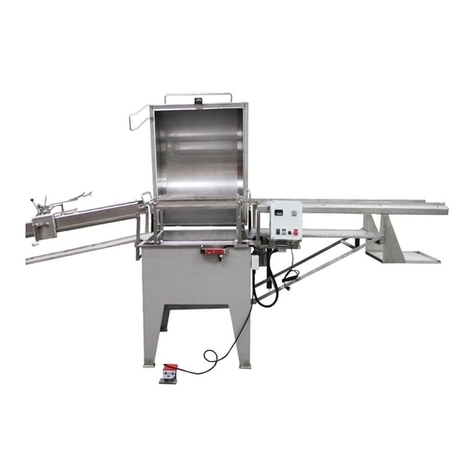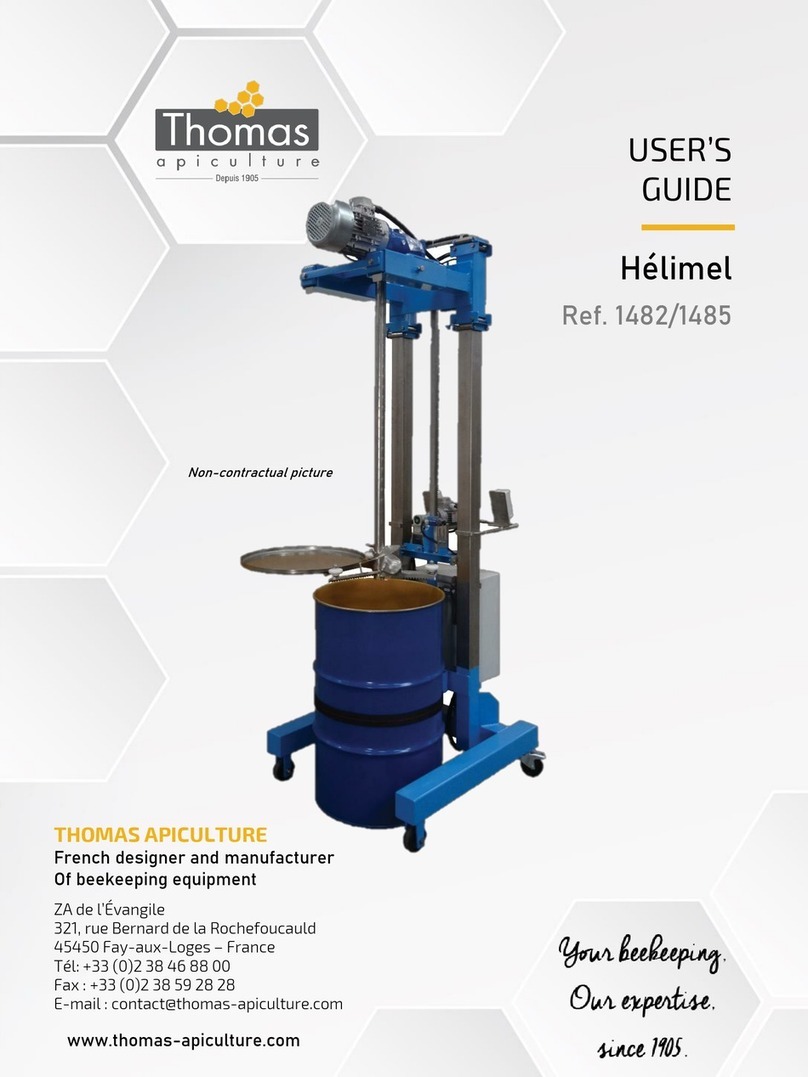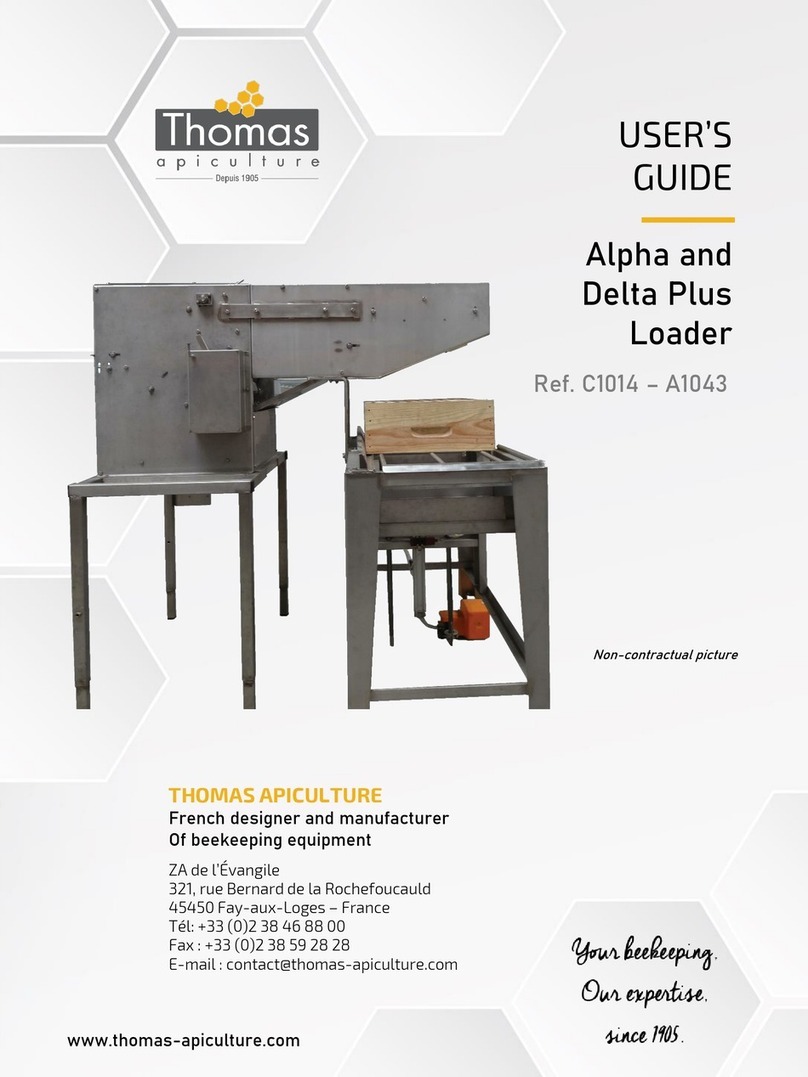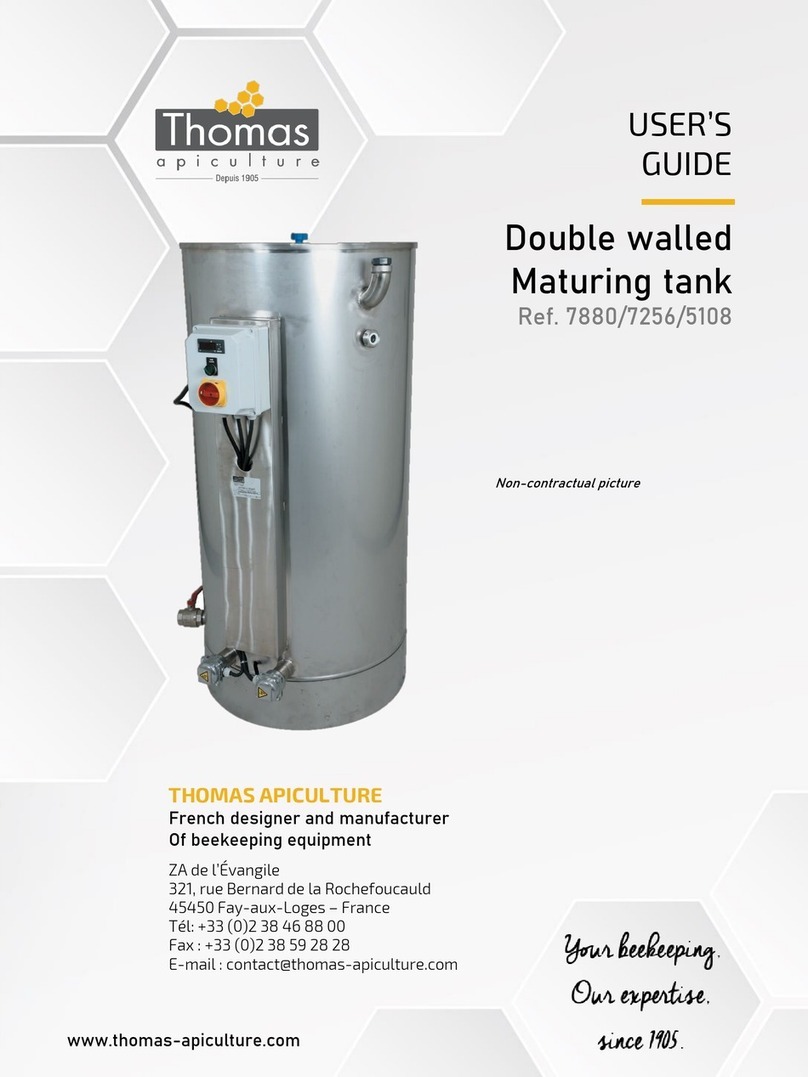Thomas TRAD 350 SO DIGIT User manual

TRAD 350 SO DIGIT
USE AND MAINTENANCE MANUAL
THOMAS S.p.A. - Via Pasubio, 32 - 36033 Isola Vicentina (VI) - Telephone 0444 / 97.61.05 - Fax 0444 / 97.69.34
Registro Imprese n. 4272// VI 116 REA n. 93906/Vicenza

2
TRAD 350 SO DIGIT
Contents
Contents ........................................................................ "2
Ordering spare parts .................................................... "2
Guarantee ...................................................................... "2
Machine certification and identification marking .... "3
CHAPTER 1
Reference to accident-prevention regulations .......... "4
1.1 -Advice for the operator ........................................... " 4
1.2 -Location of shields against accidental contact with
the tool .................................................................... " 4
1.3 -Electrical equipment according to European
Standard "CENELEC EN 60 204-1" (1992) ........... " 4
1.4 -Emergencies according to European Standard
"CENELEC EN 60 204-1" (1992) ........................... " 4
CHAPTER 2
Recommendations and advice for use ....................... "4
2.1 -Recommendations and advice for using the machine . " 4
CHAPTER 3
Technical characteristics ............................................. "5
3.1 - Table of cutting capacity and technical details
standard model ....................................................... " 5
CHAPTER 4
Machine dimensions - Transport - Installation
Dismantling ................................................................... "5
4.1 -Machine dimensions ............................................... " 5
4.2 - Transport and handling of the machine .................. " 6
4.3 -Minimum requirements for the premises
housing the machine .............................................. " 6
4.4 -Anchoring the machine ........................................... " 6
4.5 -Instructions for electrical connection ...................... " 6
4.6 -Instructions for assembly of the loose parts and
accessories ............................................................. " 6
4.7 -Disactivating the machine ....................................... " 6
4.8 -Dismantling ............................................................. " 7
CHAPTER 5
Machine functional parts ............................................. "7
5.1 -Operating head or saw frame ................................. " 7
5.2 -Vice ......................................................................... " 7
5.3 -Bed .......................................................................... " 7
CHAPTER 6
Description of the operating cycle ............................. "8
6.1 -Starting up .............................................................. " 8
6.2 - Cycle start ............................................................... " 10
6.3 - Piece-counter .......................................................... " 10
6.4 - Cutting speed ( Option ) ......................................... " 11
6.5 - Manual mode ( Option ).......................................... " 11
6.6 - Emergency .............................................................. " 11
CHAPTER 7
Regulating the machine ............................................... " 12
7.1 -Blade tension assembly .......................................... " 12
7.2 - Restoring oil level on blade tightening cylinder ...... "12
7.3 -Blade guide blocks .................................................. " 12
7.4 -Vice ......................................................................... " 13
7.5 -Saw frame return stroke limiting device ................. " 13
7.6 -Cutting angle adjustment ........................................ " 13
7.7 -Blade cleaning brush .............................................. " 13
7.8 -Changing the blade................................................. " 14
7.9 -Replacing saw frame return spring ........................ " 14
CHAPTER 8
Routine and special maintenance .............................. " 14
8.1 -Daily maintenance .................................................. " 14
8.2 - Weekly maintenance .............................................. " 14
8.3 -Monthly maintenance ............................................. " 14
8.4 -Six-monthly maintenance ....................................... " 14
8.5 -Oils for lubricating coolant ...................................... " 14
8.6 - Oil disposal ............................................................. " 14
8.7 -Special maintenance .............................................. " 14
CHAPTER 9
Material classification and choice of tool .................. "15
9.1 -Definition of materials ............................................. " 15
9.2 -Selecting blade ....................................................... " 15
9.3 - Teeth pitch .............................................................. " 15
9.4 -Cutting and advance speed .................................... " 16
9.5 -Blade running-in...................................................... " 16
9.6 -Blade structure ....................................................... " 16
9.7 -Blade type ............................................................... " 16
Shape and angle of tooth ....................................... " 16
Set........................................................................... " 17
9.7.1 - Table of recommended cutting parameters .................. "17
CHAPTER 10
Machine components ................................................... " 18
10.1- List of spare parts .................................................. " 18
CHAPTER 11
Three-phase electric diagram ..................................... " 24
Hydraulic electric diagram .......................................... " 28
CHAPTER 12
Troubleshooting ............................................................ " 29
12.1-Blade and cut diagnosis ......................................... " 29
12.2-Electrical components diagnosis ............................ " 33
CHAPTER 13
Noise tests ..................................................................... " 34
Plates and labels .......................................................... " 35
Ordering spare parts
-When ordering spare parts you must state:
MACHINE MODEL
SERIAL NUMBER
PARTREFERENCE NUMBER
Without these references WE WILL NOT SUPPLYthe spares. See point 10.1 - list of spare parts -
Guarantee
-The Company guarantees that the machine, described in this manual, has been designed to meet safety requirements. As for
machine functionality, inspection has been successful.
-The machine is guaranteed for 12 months: the guarantee does not cover the electric motors, electric components, pneumatic
components or any damage due to dropping or to bad machine management, the failure to observe maintenance standards or bad
handling by the operator.
-The buyer has only the right to replacement of the faulty parts, while transport and packing costs are at his expense.
-The serial number on the machine is a primary reference for the guarantee, for after-sales assistance and for identifying the
machine for any necessity.

3
TRAD 350 SO DIGIT
(Space reserved for the NAME and STAMP of the DEALER and/or IMPORTER)
Machine certification and identification marking
MACHINE LABEL
via Pasubio, 32 36033 ISOLA VIC. - ITALIA
MODEL
TYP
SERIAL NUMBER
YEAR OF MANUFACTURE
TRAD 350 SO DIGIT

4
TRAD 350 SO DIGIT
ited by screws that can only be removed with a special tool;
the parts are fed with alternating current at low voltage (24 V).
The equipment is protected against splashes of water and
dust.
-Protection of the system against short circuits is ensured by
means of rapid fuses and earthing; in the event of motor over-
load, protection is provided by a thermal probe.
-In case of power failure or removal of the flywheel guard, the
specific start-up button must be reset.
-The machine has been tested in conformity with point 20 of
EN 60204.
1.4 - Emergencies according to European Standard
"CENELEC EN 60 204-1"
-In the event of incorrect operation or of danger conditions, the
machine may be stopped immediately by pressing the red
mushroom button.
-The casual or voluntary removal of the protection shield of the
flywheels causes the stepping-in of a microswitch that auto-
matically stops all machine functions.
-In case blade breaks, the tightening pressure switch stops all
machine functions.
NOTE:Resetting of machine operation after each emergency
stop is achieved by reactivating the specific restart but-
ton.
RECOMMENDATIONS AND
ADVICE FOR USE
2.1 - Recommendations and advice for using the
machine
-The machine has been designed to cut metal building mate-
rials, with different shapes and profiles, used in workshops,
turner’s shops and general mechanical structural work.
-Only one operator is needed to use the machine, that must
stand as shown in the picture.
This machine has been built to comply with the national and
community accident-prevention regulations in force. Improper
use and/or tampering with the safety devices will relieve the
manufacturer of all responsibility.
1.1 - Advice for the operator
-Check that the voltage indicated on the plate, normally fixed
to the machine motor, is the same as the line voltage.
-Check the efficiency of your electric supply and earthing sys-
tem; connect the power cable of the machine to the socket
and the earth lead (yellow-green in colour) to the earthing
system.
-When the saw frame is in suspend mode (up) the toothed
blade must not move.
-Only the blade section used for cutting must be kept unpro-
tected. Remove guarding by operating on the adjustable head.
-It is forbidden to work on the machine without its shields (these
are all white, grey or blue in colour).
-Always disconnect the machine from the power socket before
blade change or carrying out any maintenance job, even in
the case of abnormal machine operation.
-Always wear suitable eye protection.
-Never put your hands or arms into the cutting area while the
machine is operating.
-Do not shift the machine while it is cutting.
-Do not wear loose clothing with sleeves that are too long,
gloves that are too big, bracelets, chains or any other object
that could get caught in the machine during operation; tie back
long hair.
-Keep the area free of equipment, tools or any other object.
-Perform only one operation at a time and never have several
objects in your hands at the same time. Keep your hands as
clean as possible.
-All internal and/or internal operations, maintenance or repairs,
must be performed in a well-lit area or where there is suffi-
cient light from extra sources so as to avoid the risk of even
slight accidents.
1.2 - Location of shields against accidental contact
with the tool
-White, grey, blue metal guards, fastened with screws onto the
stationary blade-guide and relevant holding arm.
-White, grey or blue metal guard fastened with screws onto the
mobile blade-guide,ensures covering of blade section not used
in cutting operation.
-White or grey metal guard, fastened with knobs onto the saw
frame, to protect from flywheels.
1.3 - Electrical equipment according to Euro-pean
Standard "CENELEC EN 60 204-1" which as-
similates, with some integrating modifications, the
publication "IEC 204-1"
-The electrical equipment ensures protection against electric
shock as a result of direct or indirect contact. The active parts
of this equipment are housed in a box to which access is lim-
REFERENCE TO ACCIDENT-
PREVENTION REGULATIONS
2
1

5
TRAD 350 SO DIGIT
-Before starting each cutting operation, ensure that the part is
firmly gripped in the vice and that the end is suitably sup-
ported.
These figures show examples of suitable clamping of different
section bars, bearing in mind the cutting capacities of the ma-
chine in order to achieve a good efficiency and blade durability.
-Do not use blades of a different size from those stated in the
machine specifications.
-If the blade does not cut through the material, immediately
strike the emergency push-button and switch off the machine.
Open the vice with the handwheel, remove part to be cut ad
check that the blade teeth are not broken, If they are, replace
tool.
-Check saw frame return spring to ensure proper balancing.
-Before carrying out any repairs on the machine, consult the
dealer or apply to THOMAS.
TECHNICAL
CHARACTERISTICS
3.1 - Table of cutting capacity and technical details
standard model
3
-Saw frame tilting degrees 30
-Flywheel diameter mm 330
-Blade dimensions mm 2925 x 27 x 0,9
-Vice opening mm 335
-Cooling pump electric motor kW 0,11
-Hydraulic unit motor kW 0,37
-Machine weight kg 550
MODEL WITH REDUCTION UNIT
-Three-phase electric motor - blade
rotation kW 1,3 - 1,9
-Reduction unit in oil bath ratio 1 : 40
-Blade cutting speed m/min 36 ÷ 72
MODEL WITH SPEED VARIATOR
-Three-phase electric motor - blade
rotation kW 1,5
-Blade cutting speed m/min 18 ÷ 90
90° 270 260 330x250
45° DX 230 210 230x150
60° DX 140 140 140x140
MACHINE DIMENSIONS
TRANSPORT
INSTALLATION
DISMANTLING
4.1 - Machine dimensions
4
2020
2000
1330

6
TRAD 350 SO DIGIT
4.2 - Transport and handling of the machine
If the machine has to be shifted in its own packing, use a fork-lift
truck or sling it with straps as illustrated.
chor it to the ground as shown in the diagram, using screws
and expansion plugs or tie rods sunk in cement, ensuring that
it is sitting level.
4.5 - Instructions for electrical connection
-The machine is not provided with an electric plug, so the cus-
tomer must fit a suitable one for his own working conditions:
1 - WIRING DIAGRAM FOR 4-WIRE SYSTEM FOR THREE-
PHASE MACHINE - SOCKET FOR A 16A PLUG
4.6 - Instructions for assembly of the loose parts
and accessories
-Fit the components supplied:
-Fit the bar-stop rod.
-Fit and align the roller carrying arm on the countervice
bench.
4.7 - Disactivating the machine
-If the sawing machine is to be out of use for a long period, it is
advisable to proceed as follows:
1) detach the plug from the electric supply panel
2) loosen blade
3) release the arch return spring
4) empty the coolant tank
5) carefully clean and grease the machine
6) if necessary, cover the machine.
4.8 - Dismantling
(because of deterioration and/or obsolescence)
General rules
If the machine is to be permanently demolished and/or scrapped,
divide the material to be disposed of according to type and com-
position, as follows:
1) Cast iron or ferrous materials, composed of metal alone, are
secondary raw materials, so they may be taken to an iron
foundry for re-smelting after having removed the contents
(classified in point 3);
2) electrical components, including the cable and electronic ma-
terial (magnetic cards, etc.), fall within the category of mate-
rial classified as being assimilable to urban waste accord-
ing to the laws of the European community, so they may be
set aside for collection by the public waste disposal service;
3) old mineral and synthetic and/or mixed oils, emulsified oils
and greases are special refuse, so they must be collected,
transported and subsequently disposed of by the old oil dis-
posal service.
4.3 - Minimum requirements for the premises
housing the machine
-Mains voltage and frequency complying with the machine
motor characteristics.
-Environment temperature from -10 °C to +50 °C.
-Relative humidity not over 90%.
4.4 - Anchoring the machine
-Position the machine on a firm cement floor, maintaining, at
the rear, a minimum distance of 1000 mm from the wall; an-
R = L1
S = L2
T = L3
PE = GND

7
TRAD 350 SO DIGIT
5.2 - Vice
-Material clamping system during the cutting operation by
means of an approach handwheel and hydraulic clamping. .
NOTE: since standards and legislation concerning refuse in gen-
eral is in a state of continuous evolution and therefore
subject to changes and variations, the user must keep
informed of the regulations in force at the time of dis-
posing of the machine tool, as these may differ from
those described above, which are to be considered as
a general guide line.
MACHINE FUNCTIONAL
PARTS
5.1 - Operating head or saw frame
-Part of the machine consisting of drive members (gearmotor
or variable speed motor, flywheels), tightening and guide (blade
tightening slide, blade guide head) of tool.
5
5.3 - Bed
- Structure supporting the SAW FRAME OPERATING HEAD
(revolving arm for degree cutting along with clamping sys-
tem), the VICE, the BAR STOP, the ROLLER for the support
of the mateial. The bedplate houses the cooling liquid TANK,
the CONTROL BOARD, ELECTRICAL PARTand the DEVICE
CONTROLLING THE AUTOMATIC HYDRAULIC LOWER-
ING AND RISE OF THE SAW FRAME.

8
TRAD 350 SO DIGIT
Keep your hands off the cutting area
643160 BAR
DESCRIPTION OF THE
OPERATING CYCLE
Before operating, all the main organs of the machine must
be set in optimum conditions (see the chapter on “Regulat-
ing the machine”).
6.1 - Starting up
CUTTING CYCLE:
- Vice locking
-Sawframe downfeed
-Sawframe lifting
-Vice opening
PRELIMINARY:
-Ensure that the machine is not in emergency stop condition; if
it is, release the red mushroom button ( 1) placed on the
control panel and on the foot control switch.
-Rotate the blade tension handwheel ( 3) clockwise and the
quick tension lever ( 4) towards the left against the mechani-
cal stop, until the blade tension pressure reaches 160 Bars.
-Rotate the main switch ( 5) to position 1.
-Press the key activating the hydraulic pump (see following
page).
-Check that the pressure gauge, located on the hydraulic unit
reads 30 BAR, if it doesn’t attempt to swap one of the electric
power supply wires (only during installation).
-On the standard model, select the cutting speed on commu-
tator ( 6):
Position 1 = 36 m/min.
Position 2 = 72 m/min.
FOOT CONTROL SWITCH
-Set the starting position of the sawframe according to the di-
mensions of the part to be cut: the blade must be at 10 mm
from the workpiece (see chapter 7, paragraph 7.5).
-Set device for the control of the sawframe downfeed speed,
adapting to the specifications and the shape of the material to
be cut.
-Activate the device controlling the start of the cutting cycle
(see paragraph 6.2).
-Put the piece to be cut inside the vice, approach the vice jaw
up to 3 - 4 mm.
-Start the cutting cycle. Check that blade rotates in the proper
direction, the coolant liquid flows regularly and the cutting cycle
is carried out properly until the stop of the sawframe at the top
position.
6
5

9
TRAD 350 SO DIGIT
Vice locking
+ F = Piece-counter +10pcs.
CONTROL UNIT
START START
STOP
EMERGENCY PUSH BUTTON ( 1 )
F4
Vice opening
+ F = Piece-counter zero-setting
F1
F2
F5
F
MENU'
F7
F6
F3
Sawframe raise
+ F = Piece-counter +1pc.
Sawframe downfeed
ON/OFF Hydraulic Pump.
Manual Cutting (Option)
Cycle Start
Function key (see following instructions)
Diagnosis
F8 Cycle Start
+ F = Piece-counter -1pc.

10
TRAD 350 SO DIGIT
F1
F3
F4
F2
F
6.2 - CYCLE START
-The machine is equipped with a double system to start a cutting
cycle: in fact, it is possible to start the cutting cycle either from
the control panel or from the foot control switch.
1) from the control panel pressing F7 or F8.
2) from the foot control pressing the switch.
-The machine comes from the factory with the FOOT
CONTROL SWITCH setting. However, if you want to start the
cutting cycle from the control panel, you can change the
machine setting as follows:
- Switch on the machine, press F5 key to run the hydraulic
pump. Now press and hold the key
so that F8 can be pressed at the same time for approx. 8
seconds:
-Release both keys as soon as the display starts winking.
-Repeat the same operation if you want to come back to the
previous setting.
F
F8
BLADE CUTTING DIRECTION
The machine is now ready to start work, bearing in mind that
the CUTTING SPEED and the TYPE of BLADE - combined with
a suitable lowering of sawframe - are of decisive importance for
cutting quality and for machine performance (for further details
on this topic, see below in the chapter on “Material classifica-
tion and blade selection”).
-When starting to cut with a new blade, in order to safe-
guard its life and efficiency, the first two or three cuts
must be made while exerting a slight pressure on the part,
so that the time taken to cut is about double the normal
time (see below in the chapter on “Material classification
and blade selection” in the section on Blade running-in).
-Press the red emergency button ( 1) when there are condi-
tions of danger or malfunctions in general, so as to stop ma-
chine operation immediately.
-Release the red emergency button ( 1) and press the Start
key activating the hydraulic pump to continue.
6.3 - Piece-counter
-The Control Unit counts the number of the cuts automatically.
It is possible to programm the number of the cuts so that the
machine stops automatically as soon as the programmed
number has been reached.
-Press the key:
alongwith one of the following keys :
PIECE-COUNTER ZERO-SETTING
PIECE-COUNTER +1PC.
PIECE-COUNTER -1PC.
PICE-COUNTER +10PCS.
-Note: Make the zero-setting to start again the machine.

11
TRAD 350 SO DIGIT
6.6 - Emergency
-In case the Display indicates an alphanumeric code
-Press the key:
-The following codes represent a trouble-shooting guide that
helps the operator to find out the problem :
-Release the red push-button.
E001 -Thermal relay of the hydr.unit interrupted the
circuit. Press the little red button on the relay
itself.
E008 -Insufficient blade tension or blade breakage.
- Turn Commutateur (6) to Pos.1or 2.
-Thermal feeler of Blade Motor interrupted the
circuit.
Wait some minutes to cool down the Motor.
Press the little red button on the relay
itself.
-Close the flywheel Metal Cover activating the
relevant microswitch.
-Check coolant liquid pump.
E009 - Press the key 'F5' (ON/OFF Hydraulic Pump).
E013 -Programmed cut number has been reached.
Make piece-counter zero-setting.
E014 -Sawframe limit switch (down).
E015 -Sawframe limit switch (up).
6.4 - Cutting speed ( Option )
This device permits to the change the cutting speed from 18
to 90 – m/1’.
To enter the cutting speed operate as follows :
-Close the bow downfeed regulator
-Set up the machine for the cutting process
-Turn the variator handwheel and set up the most suitable speed
according to the material to cut.
For the set up refer to the following table.
-Open the bow downfeed regulator to start cutting
WARNING : the cutting speed must be changed only when
the variator motor is turning.
STOP
6.5 - Manual Cutting (Option)
-It is possible to use the machine manually too.
-Press the key :
-Load the material to be cut and lock the vice.
-Grab the grip-switch on the lever starting the balde rotation
and the coolant pump.
-Lower the sawframe to cut the material.
-Press the key 'F6' again to abandon this function.
F6
VOLANTINO
VARIATORE
POSIZIONE N°
VELOCITA' DI
TAGLIO
m/min
118
225,5
334
441,5
549,5
657,5
765,5
873
981,5
10 90

12
TRAD 350 SO DIGIT
REGULATING
THE MACHINE
7.1 - Blade tension assembly
The ideal tightening of the blade is achieved by rotating the blade
tightening hadwheel ( B ) clockwise and rotating the lever ( A)
towards the left against the mechanical stop pin.
Ideal tightening of the blade is 160 BAR read on the relative
pressure bar ( C ).
Note: In case the saw is not used for a period of time, release
blade pressure to about 60 - 70 BAR.
Always use blades having the dimensions specified in this
manual.
77.3 - Blade guide blocks
The blade is guided by means of adjustable pads set in place
during inspection as per the thickness of the blade with mini-
mum play as shown in the figure.
In case the blade needs to be replaced, make sure to always
install 0,9 mm thick blades for which the blade guide pads have
been adjusted. In the case of toothed blades with different thick-
nesses adjustment should be carried out as follows:
-Loosen nut ( C ), screw ( B ) and loosen dowel ( D ) widening
the passage between the pads.
-Loosen the nuts ( H ) and the dowels ( I ) and rotate the
pins ( E - G ) to widen the passage between the bearings ( F
).
-Mount the new blade, place the pad ( A) on the blade and,
loosening the dowel, allow a play of 0,04 mm for the sliding of
the toothed blade; lock the relative nut and screw ( B ):
-Rotate the pins ( E - G ) until the bearings rest against the
blade as indicated in the figure and then secure the dowels (
I ) and nut ( H ).
-Make sure that between the blade and the upper teeth of the
block ( L ) this is at least 0,2 - 0,3 mm of play; if necessary,
loosen the screws that fasten the blocks and adjust accord-
ingly.
B
E
A
DC
7.2 - Restoring oil level on blade tightening
cylinder
The blade pressure can be read on the pressure gauge ( C )
mounted on the relative blade tightening cylinder allowing con-
stant display of the blade tension. (PATENTED BY THOMAS).
Ideal tightening of the blade is 160 BAR.
Should any problems in the monitoring of the tension occur, this
may be caused by the reduced capacity inside the blade tight-
ening cylinder due to an oil leak.
Simply push the blade tightening cylinder stem ( E ) back into
place and then restoring oil level through plug ( D ).
Use SHELL HYDRAULIC OIL 32 type oil or similar.
When this operation has been completed close the plug ( D )
and tighten the blade.

13
TRAD 350 SO DIGIT
7.4 - Vice
-The device does not require any particular adjustment; in case
of excess paly the sliding guide, tighten slide screw more.
7.5 - Saw frame return stroke limiting device
It consists in a mechanical adjustment system to reduce the
passive phases of the operating cycle, in other words to
eliminate the idle stroke that takes place when the size of the
part to be cut is much smaller than the maximum cutting
capacity. Practically, you adjust the starting position of the blade
in proximity of the part, independently of its dimensions.
-Slightly open the regulator controlling sawframe downfeed.
-Loose the handle ( 10 ).
-Move the sawframe either up or down approaching the blade
to 10mm from the workpiece.
DOWN UP
-Lock the handle ( 10 ).
-Attention: It is not necessary to adjust the mechanical stop
everytime; one can bring the blade near the workpiece and
then start the automatic cutting cycle which will take place
from the actual position of the blade.
-Once the cut is completed, the sawframe will raise to the upper
position (striking the relevant microswitch).
10
7.6 - Cutting angle adjustment
-Release lever ( 11 ), rotate the saw frame arm until it reaches
the mechanical stop position at far angle and check that the
zero index corresponds to 45°; if necessary operate on the
rotation stop screws to meet the index.
-Make sure that the wanted angle perfectly meets with the
reference index before locking with the lever ( 11 ).
7.7 - Blade cleaning brush
It is an ideal accessory for the cleaning of the blade during the
cutting cycle. Periodically check the condition of the brush and if
necessary proceed to further adjustment to ensure cleaning of
the blade.
11
F3
F4

14
TRAD 350 SO DIGIT
- Top up the level of lubricating coolant.
-Check blade for wear.
-Rise of saw frame to top position and partial slackening of the
blade to avoid useless yield stress.
-Check functionality of the shields and emergency stops.
8.2 - Weekly maintenance
-More accurate general cleaning of the machine to remove shav-
ings, especially from the lubricant fluid tank.
-Removal of pump from its housing, cleaning of the suction fil-
ter and suction zone.
-Clean the filter of the pump suction head and the suction area.
-Cleaning with compressed air the blade guide heads (guide
bearings and drain hole of the lubricating cooling).
-Cleaning flywheel housings and blade sliding surfaces on flywheels.
-Check the condition of the blade cleaning brushes.
8.3 - Monthly maintenance
-Check the tightening of the motor flywheel screws.
-Check the tightening of the transmission flywheel ring nut.
-Check that the blade guide bearings on the heads are perfect
running condition.
-Check the tightening of the screws of the gearmotor, pump
and accident protection guarding.
-Check shields.
8.4 - Six-monthly maintenance
(every 2000 hours)
REDUCTION UNIT
-The worm drive gear box mounteed on the machine is
maintenance-free guaranteed by its manufacture.
-Change grease using a long duration fluid for gearings such
as IP ATINA 0, or ESSO FIBER - GREASE 370 or TOTAL
CALIDRIS 0 or similar. Lubricate bearings using "extreme pres-
sure grease" DIN 51825 K-P-F2K by adding grease throught
the plug.
-Replace oil in the hydraulic unit with SHELL HYDRAULIC OIL
32 or MOBIL DTE 13 or again AGIP OSO 32 or similar.
-Check continuity of the equipotential protection circuit.
8.5 - Oils for lubricating coolant
Considering the vast range of products on the market, the user
can choose the one most suited to his own requirements, using
as reference the type SHELL LUTEM OIL ECO.
THE MINIMUM PERCENTAGE OF OIL DILUTED IN WATER IS
8 - 10 %.
8.6 - Oil disposal
The disposal of these products is controlled by strict regulations.
Please see the Chapter on “Machine dimensions - Transport -
Installation” in the section on Dismantling.
8.7 - Special maintenance
Special maintenance operations must be carried out by skilled
personnel. However, we advise contacting THOMAS or their
dealer and/or importer.Also the reset of protective and safety
equipment and devices, of the reducer, the motor, the motor pump
and electric components is to be considered extraordinary main-
tenance.
ROUTINE
AND SPECIAL
MAINTENANCE
THE MAINTENANCE JOBS ARE LISTED BELOW, DIVIDED
INTODAILY, WEEKLY, MONTHLYAND SIX-MONTHLYIN-
TERVALS. IF THE FOLLOWING OPERATIONS ARE NE-
GLECTED, THE RESULTWILL BE PREMATURE WEAR
OF THE MACHINE AND POOR PERFORMANCE.
8.1 - Daily maintenance
-General cleaning of the machine to remove accumulated shav-
ings.
-Clean the lubricating coolant drain hole to avoid excess fluid.
8
BEFORE PERFORMING THE FOLLOWING OPERATIONS,
THE ELECTRIC POWER SUPPLY AND THE POWER CABLE
MUST BE COMPLETELY DISCONNECTED.
CUTTING DIRECTION
7.8 - Changing the blade
- Lift the saw frame in upmost position.
-Loosen the blade with the handwheel, remove the mobile
blade-guide cover, open the flywheel guard and remove the
old blade from the flywheels and the blade guide blocks.
-Assemble the new blade by placing it first between the pads
and then on the races of the flywheels, paying particular atten-
tion to the cutting direction of the teeth (blade rotation diagram
page 8).
- Tension the blade to a pressure of 160 BAR and make sure it
perfectly fits inside the races of the flywheels.
-Assemble the mobile blade-guide cover and the flywheel guard
making sure that the safety microswitch is activated otherwise
when electric connection will be restored the machine will not
start.
WARNING: always use blades having dimensions specified in
this manual and for which the blade guide heads have be set:
otherwise, see chapter on “Description of the operating cycle”
in the section Starting-up.
7.9 - Replacing saw frame return spring
-When performing this operation it is necessary to keep saw
frame up using the lifting device.
-Replace the spring by loosening the upper coupling rod and
releasing it from the lower tie-rod.
RELY ON SKILLED AND QUALIFIED PERSONNEL TO RE-
PLACE OTHER MACHINE MEMBERS SUCH AS REDUCTION
UNIT OR VARIATOR, PUMP MOTOR AND ELECTRICAL
COMPONENTS.

15
TRAD 350 SO DIGIT
TYPES OF STEEL CHARACTERISTICS
USE I
UNI
D
DIN
F
AF NOR
GB
SB
USA
AISI-SAE
Hardness
BRINELL
HB
Hardness
ROCKWELL
HRB
R=N/mm²
Construction
steels
Fe360
Fe430
Fe510
St37
St44
St52
E24
E28
E36
----
43
50
----
----
----
116
148
180
67
80
88
360÷480
430÷560
510÷660
Carbon
steels
C20
C40
C50
C60
CK20
CK40
CK50
CK60
XC20
XC42H1
----
XC55
060 A 20
060 A 40
----
060 A 62
1020
1040
1050
1060
198
198
202
202
93
93
94
94
540÷690
700÷840
760÷900
830÷980
Spring
steels
50CrV4
60SiCr8
50CrV4
60SiCr7
50CV4
----
735 A 50
----
6150
9262
207
224
95
98
1140÷1330
1220÷1400
Alloyed steels for
hardening and
tempering and for
nitriding
35CrMo4
39NiCrMo4
41CrAlMo7
34CrMo4
36CrNiMo4
41CrAlMo7
35CD4
39NCD4
40CADG12
708 A 37
----
905 M 39
4135
9840
----
220
228
232
98
99
100
780÷930
880÷1080
930÷1130
Alloyed
casehardening
steels
18NiCrMo7
20NiCrMo2
----
21NiCrMo2
20NCD7
20NCD2
En 325
805 H 20
4320
4315
232
224
100
98
760÷1030
690÷980
Alloyed for
bearings 100Cr6 100Cr6 100C6 534 A 99 52100 207 95 690÷980
Tool steel
52NiCrMoKU
C100KU
X210Cr13KU
58SiMo8KU
56NiCrMoV7C100KU
C100W1
X210Cr12
----
----
----
Z200C12
Y60SC7
----
BS 1
BD2-BD3
----
----
S-1
D6-D3
S5
244
212
252
244
102
96
103
102
800÷1030
710÷980
820÷1060
800÷1030
Stainless
steels
X12Cr13
X5CrNi1810
X8CrNi1910
X8CrNiMo17133
4001
4301
----
4401
----
Z5CN18.09
----
Z6CDN17.12
----
304 C 12
----
316 S 16
410
304
----
316
202
202
202
202
94
94
94
94
670÷885
590÷685
540÷685
490÷685
Copper alloys
Special brass
Bronze
Aluminium copper alloy G-CuAl11Fe4Ni4 UNI 5275
Special manganese/silicon brass G-CuZn36Si1Pb1 UNI5038
Manganese bronze SAE43 - SAE430
Phosphor bronze G-CuSn12 UNI 7013/2a
220
140
120
100
98
77
69
56,5
620÷685
375÷440
320÷410
265÷314
Cast iron
Gray pig iron G25
Spheroidal graphite cast iron GS600
Malleable cast iron W40-05
212
232
222
96
100
98
245
600
420
MATERIAL
CLASSIFICATION AND
CHOICE OF TOOL
9
Since the aim is to obtain excellent cutting quality, the vari-
ous parameters such as hardness of the material, shape
and thickness, transverse cutting section of the part to
be cut, selection of the type of cutting blade, cutting
speed and control of saw frame lowering.These specifi-
cations must therefore be harmoniously combined in a sin-
gle operating condition according to practical considerations
and common sense, so as to achieve an optimum condition
that does not require countless operations to prepare the
machine when there are many variations in the job to be
performed.The various problems that crop up from time to
time will be solved more easily if the operator has a good
knoledge of these specifications.
WE THEREFORE RECOMMEND YOU TO ALWAYS USE
GENUINE "THOMAS" SPARE BLADES THAT GUARANTEE
SUPERIOR QUALITY AND PERFORMANCE.
9.1 - Definition of materials
The table at the foot of the page lists the characteristics of the
materials to be cut, so as to choose the right tool to use.
9.2 - Selecting blade
First of all the pitch of the teeth must be chosen, in the other
BLADE TEETH SELECTION TABLE
THICKNESS MM Z CONTINUOUS
TOOTH DESIGN
Z COMBO
TOOTH DESIGN
TILL 1.5 14 10/14
FROM 1 TO 2 88/12
FROM 2 TO 3 66/10
FROM 3 TO 5 65/8
FROM 4 TO 6 64/6
MORE THAN 6 44/6
S = THICKNESS
words, the number of teeth per inch (25,4 mm) suitable for the
material to be cut, according to these criteria:
-parts with a thin and/or variable section such as profiles, pipes
and plate, need close toothing, so that the number of teeth
used simultaneously in cutting is from 3 to 6;
-parts with large transverse sections and solid sections need
widely spaced toothing to allow for the greater volume of the
shavings and better tooth penetration;
-parts made of soft material or plastic (light alloys, mild bronze,
teflon, wood, etc.) also require widely spaced toothing;
-pieces cut in bundles require combo tooth design.
9.3 - Teeth pitch
As already stated, this depends on the following factors:
-hardness of the material
-dimensions of the section
-thickness of the wall

16
TRAD 350 SO DIGIT
9.7 - Blade type
They differ essentially in their constructive characteristics, such
as:
-shape and cutting angle of tooth
-pitch
-set
Shape and angle of tooth
REGULAR TOOTH: 0° rake and const ant pitch.
Most common form for transversal or inclined cutting of solid
small and average cross-sections or pipes, in laminated mild
steel and grey iron or general metal.
POSITIVE RAKE TOOTH: 9° - 10° positive rake and const ant
pitch.
positive
Particular use for crosswise or inclined cuts in solid sections or
large pipes, but above all harder materials (highly alloyed and
stainless steels, special bronze and forge pig).
COMBO TOOTH: pitch varies between teeth and consequently
varying teeth size and varying gullet depths. Pitch varies be-
tween teeth which ensures a smoother, quieter cut and longer
blade life owing to the lack of vibration.
SOLID Ø OR L MM Z CONTINUOUS
TOOTH DESIGN
Z COMBO
TOOTH DESIGN
TILL 30 85/8
FROM 30 TO 60 64/6
FROM 40 TO 80 44/6
MORE THAN 90 33/4
Ø = DIAMETER L = WI DTH
9.4 - Cutting and advance speed
The cutting speed (m/min) and the advance speed (cm2/min =
area travelled by the blade during removal of chip) are limited
by the development of heat close to the tips of the teeth.
-The cutting speed is subordinate to the resistance of the ma-
terial (R = N/mm2), to its hardness (HRC) and to the dimen-
sions of the widest section.
- Too high an advance speed (= lowering of the saw frame)
tends to cause the blade to deviate from the ideal cutting path,
producing non rectilinear cuts on both the vertical and the
horizontal plane.
The best combination of these two parameters can be seen
directly examining the chips.
Long spiral-shaped chips indicate ideal
cutting.
Very fine or pulverized chips indicate lack
of feed and/or cutting pressure.
Thick and/or blue chips indicate overload
of the blade.
9.5 - Blade running-in
When cutting for the first time, it is good practice to run in
the tool making a series of cuts at a low advance speed
(= 30-35 cm2/min on material of average dimensions with re-
spect to the cutting capacity and solid section of normal steel
with R = 410-510 N/mm2), generously spraying the cutting
area with lubricating coolant.
9.6 - Blade structure
Bi-metal blades are the most commonly used. They consist in a
silicon-steel blade backing with electron beam or laser welded
high speed steel (HHS) cutting edge. The type of stocks are
classified in M2, M42, M51 and differ from each other because
of their major hardness due to the increasing percentage of
Cobalt (Co) and molybdenum (Mo) contained in the metal alloy.
distance between teeth
distance between teeth
Another advantage offered in the use of this type of blade in the
fact that with an only blade it is possible to cut a wide range of
different materials in size and type.
COMBO TOOTH: 9° - 10° positive rake.
positive
This type of blade is the most suitable for the cutting of section
bars and large and thick pipes as well as for the cutting of solid
bars at maximum machine capacity. Available pitches: 3-4/4-6.

17
TRAD 350 SO DIGIT
This set is associated with very fine teeth and it is mainly used
for the cutting of pipes and thin section bars (from 1 to 3 mm).
ALTERNATE SET (IN GROUPS): Groups of cutting teeth right
and left, alternated by a straight tooth.
This set is associated with very fine teeth and it is used for
extremely thin materials (less than 1 mm).
ALTERNATE SET (INDIVIDUAL TEETH): Cutting teeth right
and left.
This set is used for the cutting of nonferrous soft materials,
plastics and wood.
Set
Saw teeth bent out of the plane of the saw body, resulting in a
wide cut in the workpiece.
REGULAR OR RAKER SET: Cutting teeth right and left, alter-
nated by a straight tooth.
Of general use for materials with dimensions superior to 5 mm.
Used for the cutting of steel, castings and hard nonferrous ma-
terials.
WAVY SET: Set in smooth waves.
9.7.1 - RECOMMENDED CUTTING PARAMETERS
STEEL CUTTING SPEED LUBRICATION REMOVAL cm²/min
CONSTRUCTION 60/80 EMULSIFIABLE OIL 40/60
CEMENTATION 40/50 EMULSIFIABLE OIL 20/40
CARBON STEEL 40/60 EMULSIFIABLE OIL 40/60
HARDENING AND TEMPERING 40/50 EMULSIFIABLE OIL 30/50
BEARINGS 40/60 EMULSIFIABLE OIL 15/30
SPRINGS 40/60 EMULSIFIABLE OIL 10/30
FOR TOOLS 30/40 EMULSIFIABLE OIL 6/20
FOR VALVES 35/50 EMULSIFIABLE OIL 20/30
STAINLESS STEEL 30/40 EMULSIFIABLE OIL 6/20
SPHEROIDAL GRAPHITE 20/40 EMULSIFIABLE OIL 6/30
CAST IRON 40/60 EMULSIFIABLE OIL 30/60
ALUMINIUM 80/600 KEROSENE 60/450
BRONZE 70/120 EMULSIFIABLE OIL 40/70
HARD BRONZE 30/60 EMULSIFIABLE OIL 6/20
BRASS 70/350 EMULSIFIABLE OIL 25/80
COPPER 50/720 EMULSIFIABLE OIL ------

18
TRAD 350 SO DIGIT
10 MACHINE COMPONENTS
10.1 - List of spare parts
BEDPLATE ASSEMBLY
REFERENCE N° DESCRIPTION
001 Bed
002 Arm locking lever
003 Arm locking bushing
004 Lever handgrip
005 Saw frame lowering
adjustment
006 Emergency push-button
007 Roller supporting arm
008 Roller
009 Ring OR 4081
010 Revolving arm locking pin
011Grid
REFERENCE N° DESCRIPTION
012 Electropump
013 Ring NILOS 32010 XAV
014 Bearing 32010 X
015 Eccentric bushing
016 Ring nut GUK M 45 x 1,5
017 Revolving arm
018 Electric box
019 Bearing 32009 X
020 Ring NILOS 32009 XAV
021 CYCLE STARTpedal
021

19
TRAD 350 SO DIGIT
HYDRAULIC VICE
REFERENCE N° DESCRIPTION
101 Countervice
102 Vice
103
104 Vice thread for hydraulic
drive
105 Saw frame arm rotation pin
106 O-Ring 4081
107 Bar-stop rod
108 Bar-stop
109 Bar-stop push rod
110 Millimetre ruller
111 No-burr jaw
REFERENCE N° DESCRIPTION
112 Counter vice iaw
113 Vice jaw
114 Hydrailic drive vice
cylinder
119 Vice handwheel
120 Washer
121 No-burr plate
122 Locking bush

20
TRAD 350 SO DIGIT
SAW FRAME UNIT
Table of contents
Other Thomas Industrial Equipment manuals
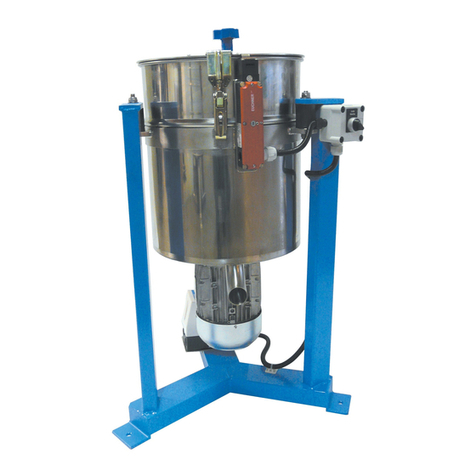
Thomas
Thomas 836 User manual
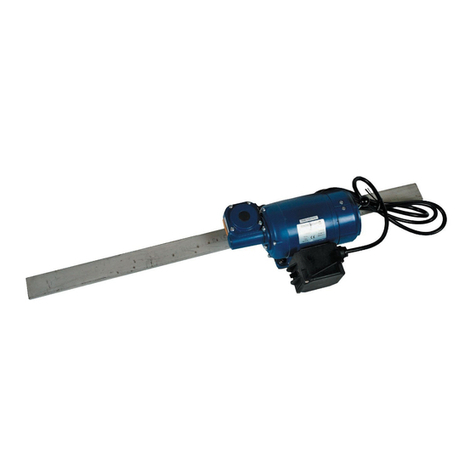
Thomas
Thomas Adaptmatic User manual
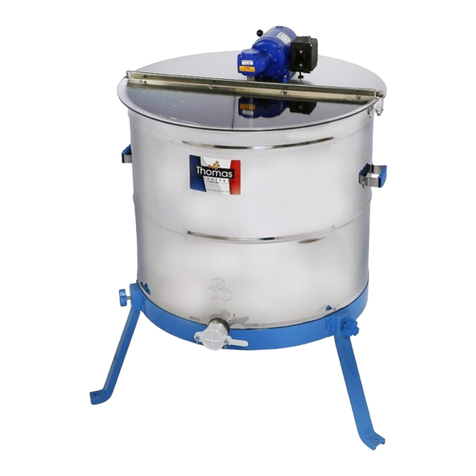
Thomas
Thomas 6512 User manual
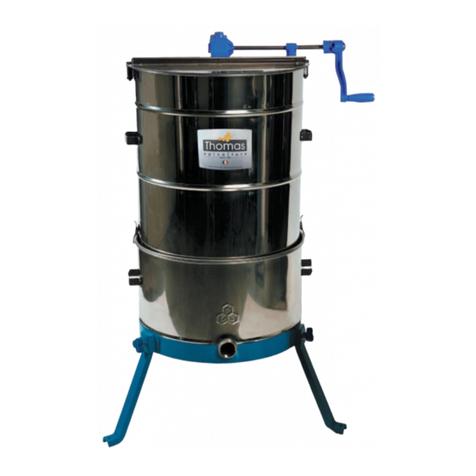
Thomas
Thomas 7175 User manual
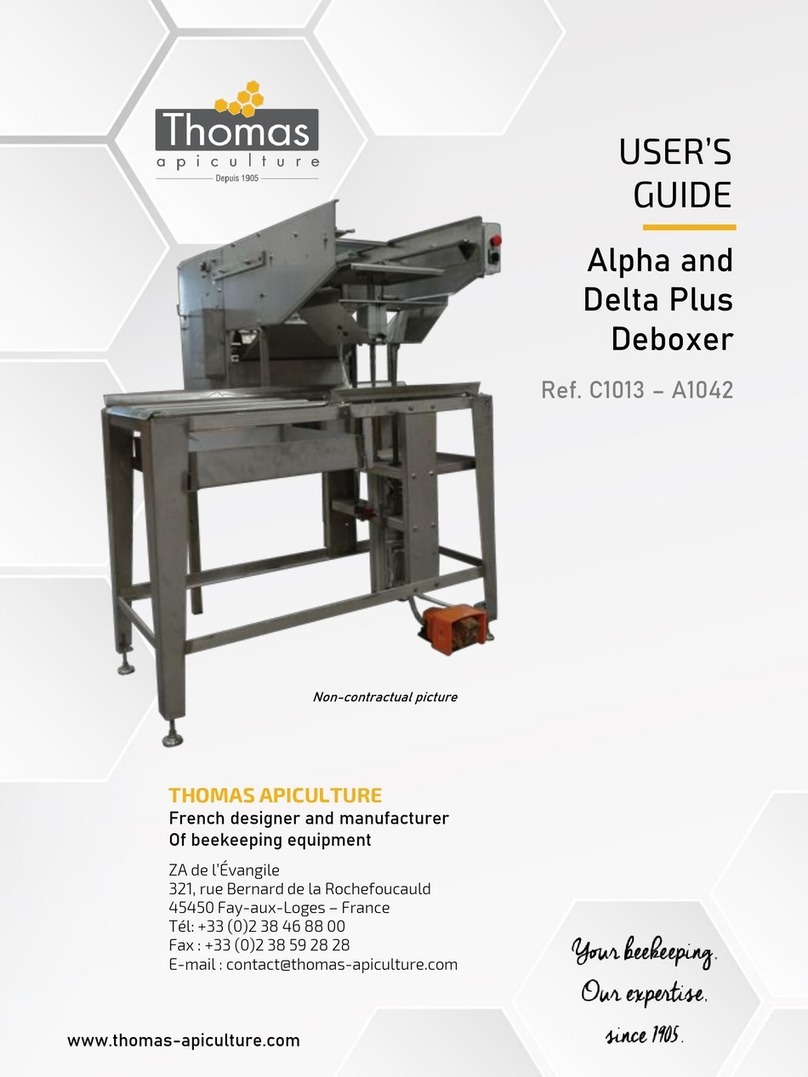
Thomas
Thomas C1013 User manual
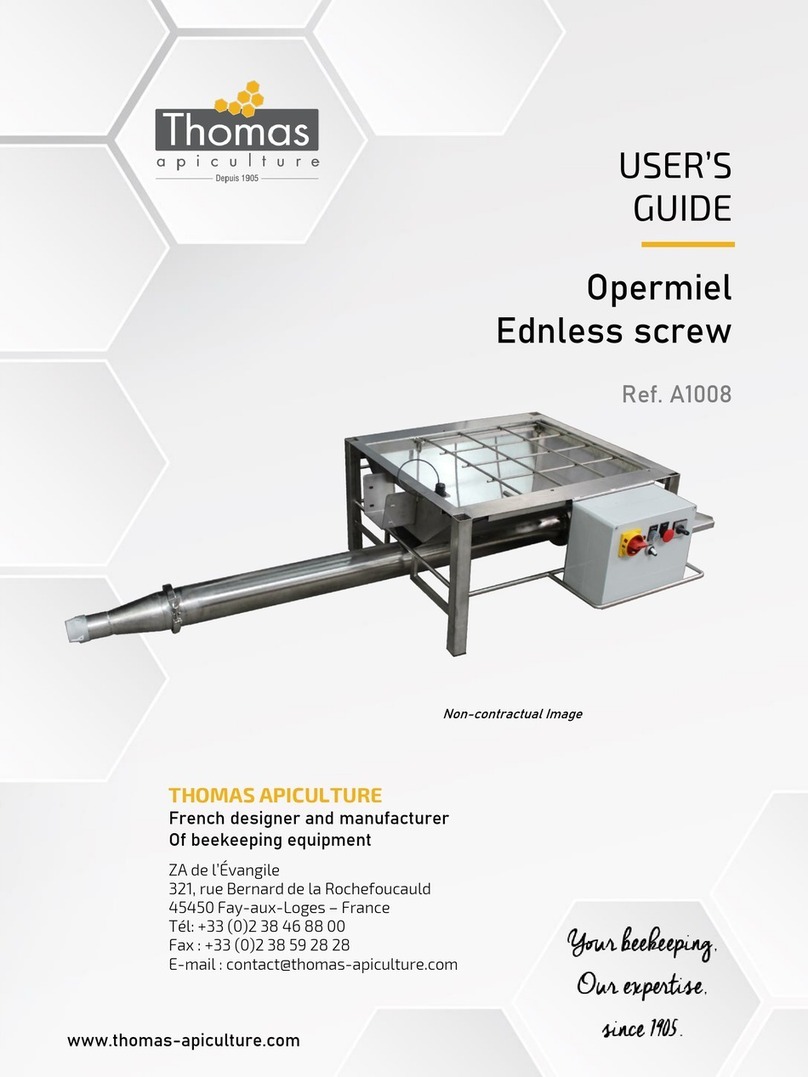
Thomas
Thomas A1008 User manual
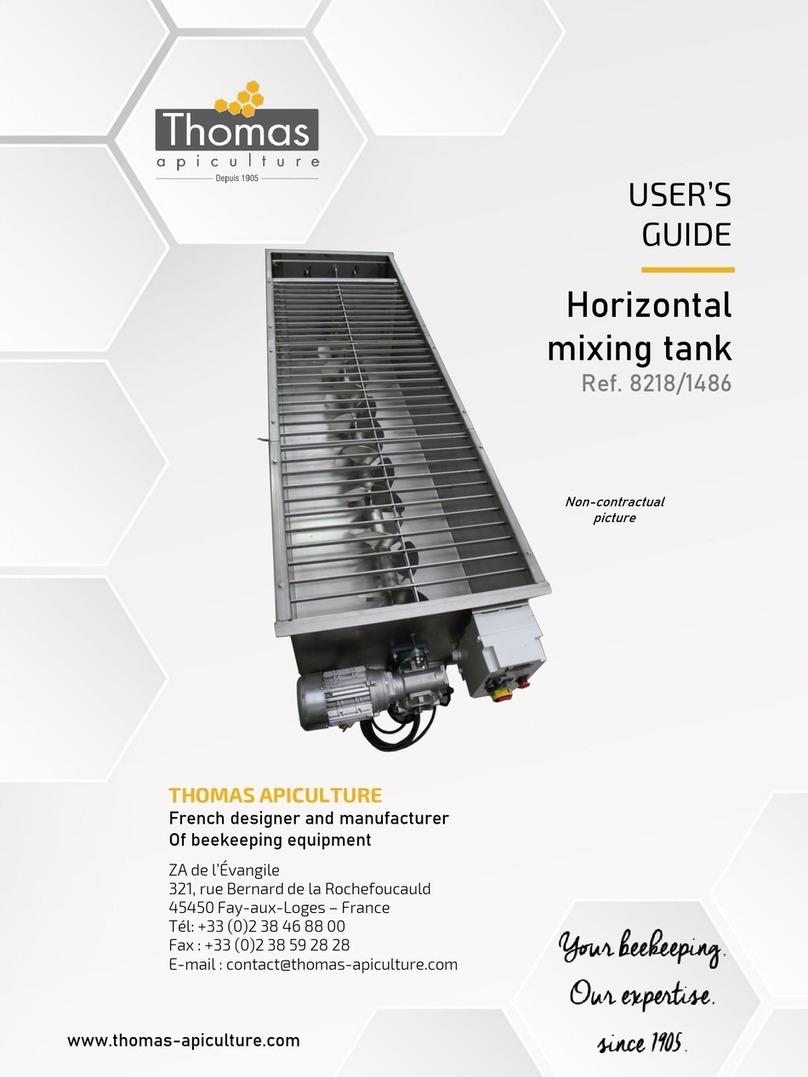
Thomas
Thomas 8218 User manual
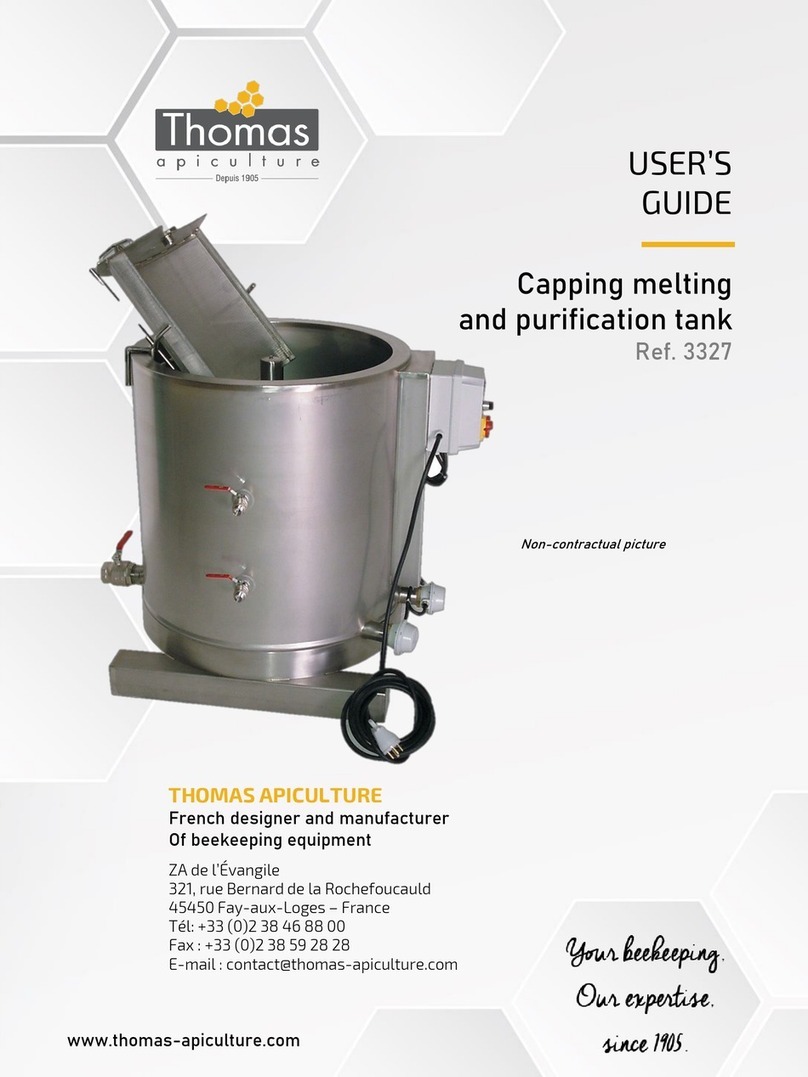
Thomas
Thomas 3327 User manual
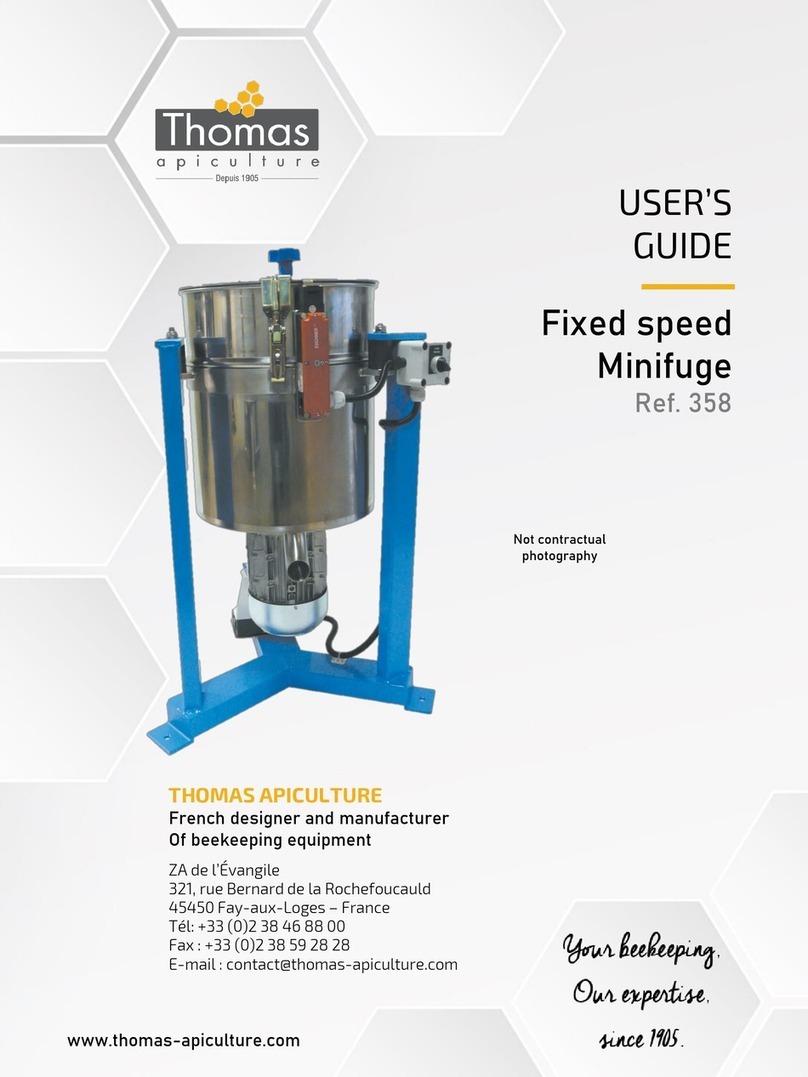
Thomas
Thomas 358 User manual
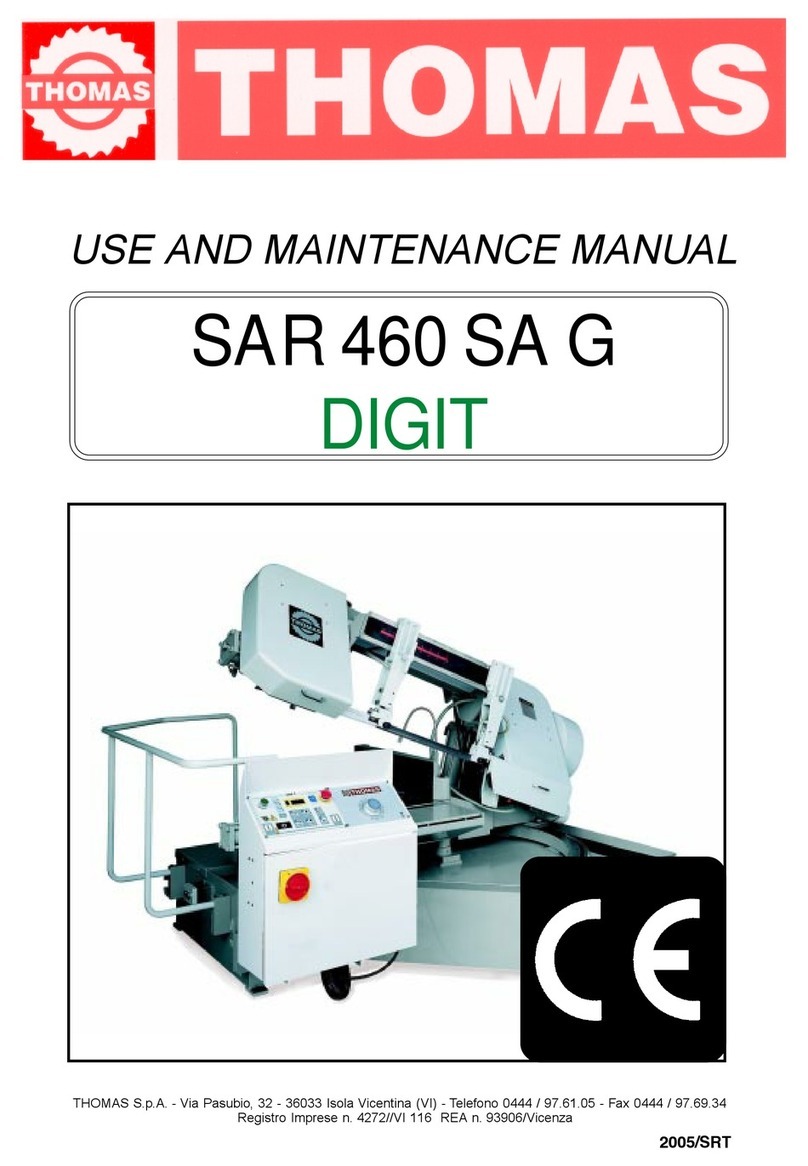
Thomas
Thomas SAR 460 SA G DIGIT User manual
